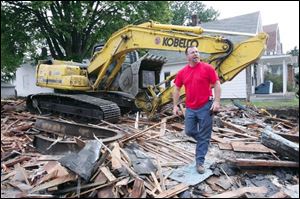
Demolition expert combats city blight
10/1/2007
Richard Hendrickson inspects his handiwork after tearing down a nuisance property on West Central Avenue last week. Known as 'the King' by his co-workers, Mr. Hendrickson says it's sad to see buildings be-come neglected, but he takes pride in taking them down safely and is happy when cleared sites are developed anew for the neighborhood.
Richard Hendrickson likes to call his work "reverse construction," and while it doesn't take nearly as long as putting a building up, he takes just as much pride in his work as any carpenter.
Official estimates don't exist, but Mr. Hendrickson, 45, the main excavator operator for the city's housing demolition crew, figures he has leveled as many as 3,000 houses in his career - the equivalent of about 75 city blocks.
"I love it," he said. "Every job is a challenge. Every house is different. They come down differently. I pride myself on the ability to take it down safely without damaging the neighboring house."
The city's current 300-a-year goal of demolishing derelict houses began in 1994, one year after the pilot project began. Mr. Hendrickson, although relatively low in seniority, saw the posting and immediately wanted to be part of it.
"As soon as the demo came along I wanted to do demo," he said. "I wanted to run the equipment." The first year they used bulldozers, rather than backhoes, and pushed down 26 houses, he recalls.
"We were learning as we went along," Mr. Hendrickson said. "We were self-taught."
He estimates the city's demolition cost at $2,500 to $3,000 for a medium-sized house, possibly half the cost of a private demolition.
Among his projects last week was a former motorcycle clubhouse at 1601 West Central Ave. that had been the subject of neighborhood parking, crime, and noise complaints for the last seven years.
The city razes houses that are deemed to be neighborhood nuisances because of their dilapidated condition, either from neglect or fire, and when the owner refuses to take responsibility, or in an emergency. The list of homes slated for elimination stretches into 2008, he said.
Before the demolition crew arrives, the water, gas, and electrical utilities have been disconnected. The excavator, also known as a backhoe, is delivered to the site on a flatbed truck.
After he checks inside the house for occupants and to identify the largest room, Mr. Hendrickson uses the shovel of the 62,000-pound machine to punch a hole in the wall. From there, he opens up the basement, and then pushes the house into the foundation in fragments of lumber, plaster, brick, shingles, and whatever else went into its construction.
The demolition crew returns later to load the debris into a truck and take it to a landfill.
Mr. Hendrickson operates the excavator two days a week, and then drives a truck the other three days.
David Welch, commissioner of streets, bridges, and harbor, said the demolition crew contracts with the Department of Neighborhoods, which schedules homes for demolition.
"If you've got a house demolition between two houses with very short clearance he's the guy you want to knock down that house. He does excellent work and takes pride in that work," Mr. Welch said. He said the demolition crew takes down 10 to 15 houses a week, and is at around 230 for the year so far.
Mr. Hendrickson's immediate supervisor, Mike Scott, said he has three demolishers, of whom Mr. Hendrickson is the most senior.
Mr. Hendrickson's co-workers call him "the King," said James Foster, 63, the utility worker on the crew.
"He loves his job. Well, we all do," said Mr. Foster, who usually runs the water hose and makes sure adjacent houses are safe. "Most of the people are so happy when we come because it's a blight in the neighborhood."
The crew works five 10-hour days, and often at night and on weekends for emergency demolitions.
Mr. Hendrickson said it's sad that a house has been left to deteriorate, and it's sad when he has to roust homeless people who have taken shelter there.
But he takes pride in the new developments that have arisen on the remains of demolished buildings - the Toledo Jeep Assembly plant, the Toledo Correctional Institution on East Central Avenue, the entrance to the Amtrak station at Martin Luther King, Jr., Plaza, and the shopping center and new homes near Dorr Street and Collingwood Boulevard.
Many other razed houses are now just gaps in the residential streetscape.
There have been a few mishaps, such as the time Mr. Hendrickson was directed to the wrong house for demolition. He kicked in the door to make his usual interior check, and found a family sitting in the living room watching television.
The city paid for a new door.
A native of Fort Myers, Fla., Mr. Hendrickson's family moved to the Toledo area when he was about 5. He went to Anthony Wayne Schools, graduating from Anthony Wayne and Penta County Vocational High Schools.
After three years in the Army, he worked multiple jobs, including 17 years as a security guard at Westfield Franklin Park. Mr. Hendrickson started with the city in 1989, continuing part-time with Franklin Park for a period.
He and his wife of 18 years, Theresa, live in Toledo and have three children, Lauren, 17, Dalton, 15, and Jenna, 8.
Mr. Hendrickson said as destructive as his work is, it's popular with every neighborhood that has a nuisance house.
"Everybody loves me. They see me coming, they know I'm coming to take down a house," he said.
Contact Tom Troy at: tomtroy@theblade.com or 419-724-6058.